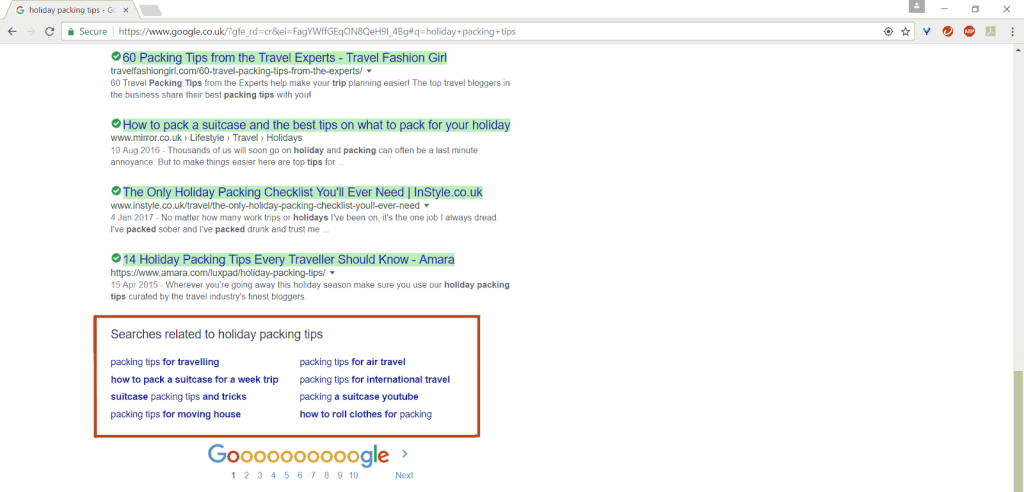Having great quality content is crucial in getting your page to rank – you need to give visitors something worth visiting if you want your page to succeed! But let’s say you’ve already created some great work (if not, we have some ideas how to improve it) – how can you get it noticed by Google (and thus, by potential visitors who may be interested in your page)?
This is where a content audit checklist comes in. We’ve put together this basic breakdown so you can assess your content’s overall optimisation quickly and easily, so it’ll be noticed and surfaced more often by search engines like Google.
1. Are you using keywords everywhere that’s relevant?
Google, and other search engines, are a bit like matchmakers – they want to pair visitors who are searching for specific terms with websites that answer those specific terms. So, in order to signal to Google which terms you can answer to, you need to give each of your pages a unique focus keyword – this will give Google a better idea of what your page is about, so it knows to display it to visitors who are searching for the same thing.
So, with your focus keyword in mind, you need to check: is it in your:
- Title tag (especially at the front of your Title tag, if possible)?
- alt-text of your images?
- Webpage URL?
- Meta description (i.e. the snippet of text search engines display under your title in search results)?
- In your H1s and H2s (the specific heading tags that search engines like Google use to understand what your page is about)?
- In the page content itself (preferably at the beginning of content especially)?
Of course, it’s not just about stuffing keywords into your page left right and centre (search engines do not look on this very fondly – and neither do visitors who have to look at a page that reads very unnaturally!); the content has to be good quality and genuinely serve the needs of the visitor. But this is a good way, once your content is in order, to help boost the signal to Google that this is the webpage they should be showing to visitors when they search for your keyword.
2. Are you using related keywords?
Having a focus keyword and targeting it properly is great, but the next step from there would be to make sure you’re also using other related keywords. The ways this works is that when a visitor is searching for something, they are probably also interested in a ‘cloud’ of other related terms as well. For example, if I searched for ‘holiday packing tips’, I may also be interested in ‘packing for a week trip’, or ‘for international travel’. If these related keywords are also used on your page, this signals to Google that you are serving the needs of the searcher comprehensively, and they will be more likely to display your page in results.
An easy way to identify such keywords is by looking through Latent Semantic Indexing keywords (LSI keywords), and Adword ads. For LSI keywords the way to do this is to simply type your keyword into Google, then scroll to the bottom of the page where the list of related searches would tell you what else people are searching for around your keyword.

With Adwords, you need to look at the Ads around your keywords and identify which you can use – it’s a handy source because the fact that they have been displayed in the Ads area demonstrates that Google believes they are a relevant search result, so they must be doing something right!

Once you have your list of related keywords, you need to check:
- Are these related keywords included in any of my H2s?
- Are these related keywords included in the body content of my page?
3. Are your character counts the right length?
Searchers are ultimately looking for content that is high quality but also easy to access. This means that content should be long – a minimum of 300 words per page, ideally – as users looking for answers to their search queries are unlikely to find it in a one-liner. This also means that URLs, titles, and more should be short and snappy, so that they’re easy for the searcher to read and remember. If you do this, search engines will also have an easier time identifying what your page is about, and are less likely to modify your display results according to what they believe is most important. Keep things within character and pixel guidelines to keep control over what the search engine – and visitor – see when looking at your result in a search engine:
- Is the content on the page at least 300 words?
- Is the title under 571 pixels/65 characters?
- Is the meta description below 930 pixels/156 characters?
- Is the URL easy to remember?
Note: Just as it’s important to keep titles and meta descriptions short, be careful not to make them too short – you want to make sure they are still descriptive enough that the searcher knows what they are getting when they click on your result!
4. Do you have good internal and external links?
Internal and external links are good for different things. It is good to have internal links as it keeps viewers on your site for longer, and reduces bounce rate. It is especially good to have a few near the beginning of your page, as this will help retain visitors who may have seen your page and decided it wasn’t relevant to them, and thus ‘bounced’ – this gives them a chance to look at something else that may catch their interest.
External links are good for signalling to Google that you are not simply trying to hoard page rank for yourself, but are a good web citizen and helping visitors find more sites that would answer their needs! You don’t need to overdo this, but a couple of links to some sites of good reputation wouldn’t hurt. So:
- Do you have at least 2 or 3 internal links, especially near the beginning of your page?
- Do you have 2 external links to websites of authority/good reputation?
5. Are your images optimised?
An aspect that is sometimes overlooked, but is nevertheless an important part of good content, are images. It’s been proven that pages with a combination of media (i.e. not just text) are seen to have greater value, so images are worth paying attention to. We have an article that goes into optimising images more thoroughly, but as a basic overview, you should check:
- Do your images have descriptive alt-text that use relevant keywords?
- Do your images have accurate file names with relevant keywords?
- Are your images under 100kb, so they don’t slow down page loading time too much?
- Is your image the right physical dimensions (i.e. not a big image being resized to look small in the code)?
